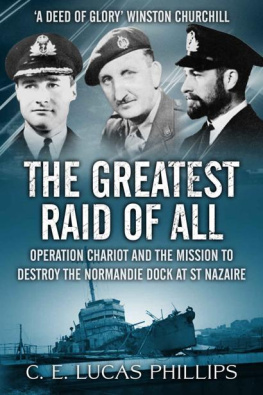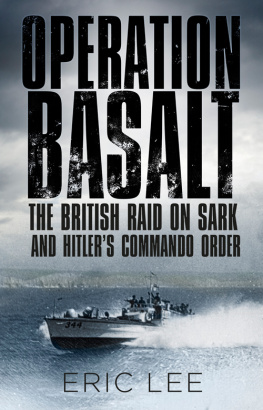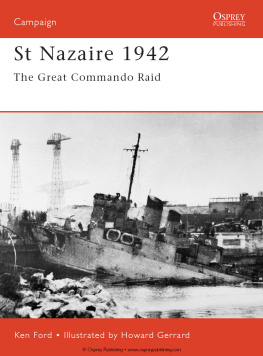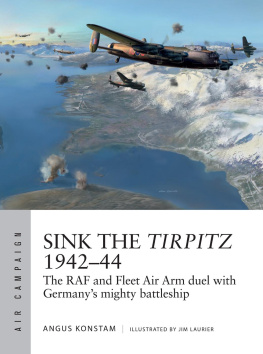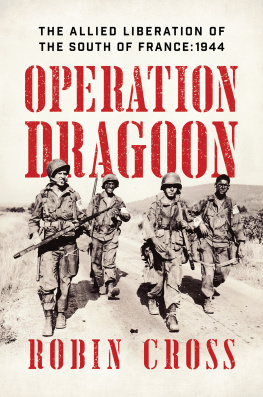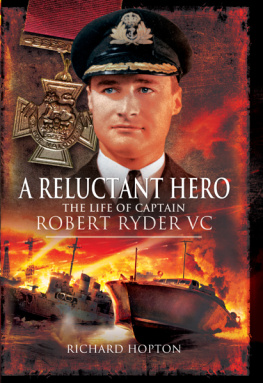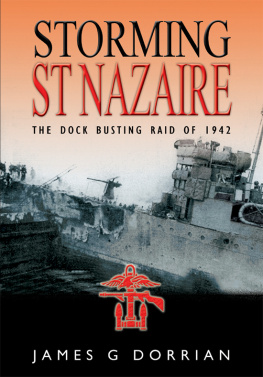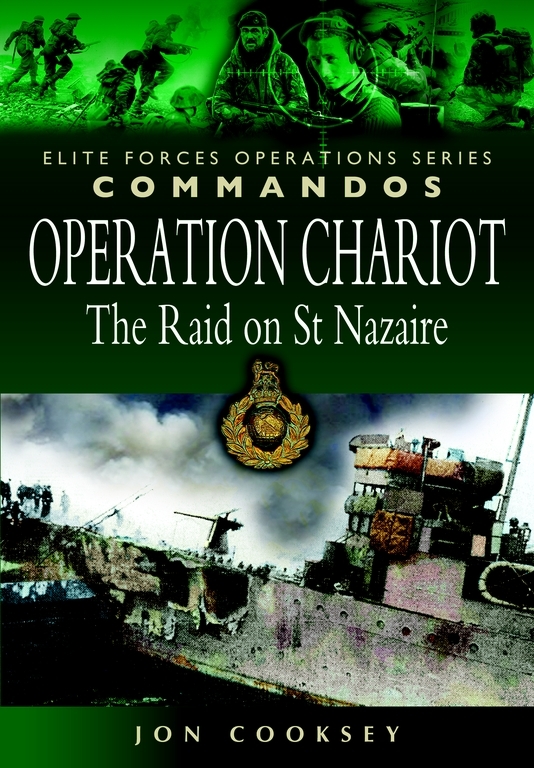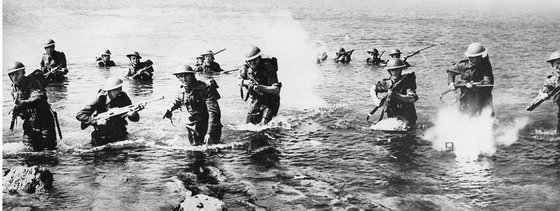Stuart Chant-Sempill, St. Nazaire Commando (London: John Murray, 1985)
James G. Dorrian, Storming St. Nazaire-The Dock Busting Raid of 1942 (Barnsley: Leo Cooper, 2001)
C.E. Lucas Phillips, The Greatest Raid of All (London: Pan, 2000)
Kenneth Macksey, Commando Strike The Story of Amphibious Raiding in World War II (London: Leo Cooper, 1985)
Robin Neillands, The Raiders The Army Commandos 1940-46 (London: Weidenfeld and Nicolson, 1989)
Winston G. Ramsey, The Raid on Saint Nazaire After the Battle , 59, (1988)
Robert Ryder, The Attack on St. Nazaire (London: John Murray, 1947)
ST NAZAIRE OPERATION CHARIOT
THERES CERTAINLY A VC IN THIS ON RAIDING
By Robin Neillands
Author and broadcaster Robin Neillands is a former Royal Marines
Commando. He has written more than forty books on military
history, including The Raiders The Army Commandos 1940-46
(Weidenfeld and Nicolson 1989) . A member of the British
Commission for Military History, he lectures extensively and
conducts battlefield tours in Europe and the United States.
Historians of irregular warfare have come to call the St. Nazaire Raid Operation CHARIOT the greatest raid of all. This assessment is probably true in daring, in skill of execution, in gallantry against odds and, above all, in results, the St. Nazaire Raid stands well beyond all the other Commando raids of the Second World War.
The raid also stands out because it comes almost at the end of the raiding phase for Britains Commando forces. The Dieppe Raid, which took place a few months later, in August 1942, marks the start of a new phase - full-scale amphibious operations - for it involved an entire division of Canadian soldiers, warships and aircraft as well as No. 3 and No. 4 Commandos and the Royal Marine A Commando. The Dieppe Raid marked a change from raiding tasks carried out by a few men, perhaps a platoon, at most a company, to amphibious operations that were in fact preparations for the biggest amphibious operation of all, Operation Overlord, on D-Day, 6th June, 1944.
And yet the divide is not complete and the split not definitive; small scale raiding led to larger raids like St. Nazaire and so on to the big amphibious operations without which the enemy could not have been defeated; the Channel that protected Britain in 1940 was a moat that the Allied invasion armies had to cross in 1944.
Britains Commando forces were formed in 1940, after the Dunkirk debacle, and for several very good reasons. First of all, in that dark hour, it was necessary to show the enemy, in spite of Dunkirk, that the spirit of resistance was still high among the British, that they would hit back at every opportunity and would carry the war to the enemy by whatever means were available, however small.
Nor was there long to wait. The French surrendered to the Germans on June 25th 1940. The first British unit to go by the name Commando John Durnford Slaters No. 3 Commando - was formed on June 28th and mounted its first raid, Operation Ambassador, on Guernsey just two weeks later, on the night of July 14th. For the next four years the Commandos were constantly in action, all over the world, from the snows of Norway to the jungles of South-East Asia, from the islands of the Adriatic to the beaches of Normandy - as the quote from the Second Book of Samuel says on the Commando memorial in Westminster Abbey They performed whatsoever the King commanded.
They performed whatsoever the King commanded.
The development of raiding forces by the British Army seems somewhat surprising for the British military mind tends to be conservative. The development of Commando forces was not welcomed with great enthusiasm at the War Office or among many parts of the Regular Army who regarded Commando soldiering as a diversion from the main task of defeating the enemy in the field by conventional means. The fact remains that during the Second World War no nation, or Army, did more to develop and foster the use of irregular forces than the British.
Irregular forces appeared in every theatre where the British Army was engaged Chindits in the Far East and Burma, the Long Range Desert Group (LRDG) and the Special Air Service (SAS) in North Africa where highly irregular units like the quaintly named Popskis Private Army a force raiding in jeeps and commanded by a Polish migr - was also born before going on to fight in Italy. To these can be added such little-known units as the Small Scale Raiding Force, which operated across the Channel in a fast motor boat engagingly entitled The Little Pisser, and the Royal Marine raiders of the Boom Patrol Detachment, the forerunner of the Special Boat Squadron or SBS, or COPP, the Combined Operations Pilotage Parties, that swam ashore by night to recce enemy beaches.
Nor was it just the Army and the Royal Marines a Corps which produced nine Commando units during the Second World War and retains the Commando tradition to this day in the 3rd Commando Brigade, Royal Marines.



